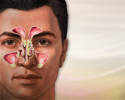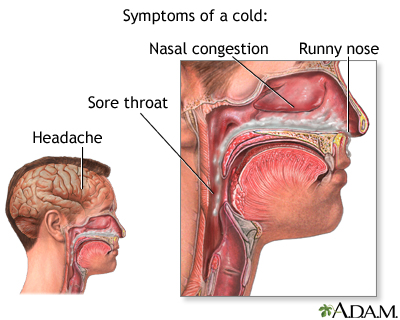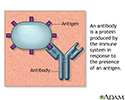Common cold
Upper respiratory infection - viral; ColdThe common cold most often causes a runny nose, nasal congestion, and sneezing. You may also have a sore throat, cough, headache, or other symptoms.
Causes
It is called the common cold for good reason. There are over one billion colds in the United States each year. You and your children will probably have more colds than any other type of illness.
Colds are the most common reason that children miss school and parents miss work. Parents often get colds from their children.
Children can get many colds every year. They usually get them from other children. A cold can spread quickly through schools or daycares.
Colds can occur at any time of the year, but they are most common in the winter or rainy seasons.
A cold virus spreads through tiny, air droplets that are released when the sick person sneezes, coughs, or blows their nose.
You can catch a cold if:
- A person with a cold sneezes, coughs, or blows their nose near you
- You touch your nose, eyes, or mouth after you have touched something contaminated by the virus, such as a toy or doorknob
People are most contagious for the first 2 to 3 days of a cold. A cold is most often not contagious after the first week.
Symptoms
Cold symptoms usually start about 2 or 3 days after you came in contact with the virus, although it could take up to a week. Symptoms mostly affect the nose.
The most common cold symptoms are:
- Nasal congestion
Nasal congestion
A stuffy or congested nose occurs when the tissues lining it become swollen. The swelling is due to inflamed blood vessels. The problem may also in...
 ImageRead Article Now Book Mark Article
ImageRead Article Now Book Mark Article - Runny nose
Runny nose
A stuffy or congested nose occurs when the tissues lining the nose become swollen. The swelling is due to inflamed blood vessels. The problem may a...
 ImageRead Article Now Book Mark Article
ImageRead Article Now Book Mark Article - Scratchy throat
- Sneezing
Sneezing
A sneeze is a sudden, forceful, uncontrolled burst of air through the nose and mouth.
 ImageRead Article Now Book Mark Article
ImageRead Article Now Book Mark Article
Adults and older children with colds generally have a low fever or no fever. Young children often run a fever around 100°F to 102°F (37.7°C to 38.8°C).
Depending on which virus caused your cold, you may also have:
- Cough
Cough
Coughing is an important way to keep your throat and airways clear. But too much coughing may mean you have a disease or disorder. Some coughs are d...
 ImageRead Article Now Book Mark Article
ImageRead Article Now Book Mark Article - Decreased appetite
- Headache
Headache
A headache is pain or discomfort in the head, scalp, or neck. Serious causes of headaches are rare. Most people with headaches can feel much better...
 ImageRead Article Now Book Mark Article
ImageRead Article Now Book Mark Article - Muscle aches
Muscle aches
Muscle aches and pains are common and can involve more than one muscle. Muscle pain also can involve ligaments, tendons, and fascia. Fascias are th...
 ImageRead Article Now Book Mark Article
ImageRead Article Now Book Mark Article - Postnasal drip
Postnasal drip
A stuffy or congested nose occurs when the tissues lining the nose become swollen. The swelling is due to inflamed blood vessels. The problem may a...
 ImageRead Article Now Book Mark Article
ImageRead Article Now Book Mark Article - Sore throat
Sore throat
Pharyngitis, or sore throat, is discomfort, pain, or scratchiness in the throat. It often makes it painful to swallow.
 ImageRead Article Now Book Mark Article
ImageRead Article Now Book Mark Article
Mild symptoms of COVID-19 may be similar to those of the common cold. Always check with your provider if you are at risk for COVID-19.
Treatment
Most colds go away in a few days. Some things you can do to take care of yourself with a cold include:
Take care of yourself
Colds are very common. A visit with your health care provider is often not needed, and most colds get better in about a week. Some symptoms, such a...

- Get plenty of rest and drink fluids.
- Over-the-counter (OTC) cold and cough medicines may help ease symptoms in adults and older children. They do not make your cold go away faster, but can help you feel better. These OTC medicines are not recommended for children under age 4.
- Antibiotics should not be used to treat a common cold.
- Many alternative treatments have been tried for colds, such as vitamin C, zinc supplements, and echinacea. Talk to your health care provider before trying any herbs or supplements.
Outlook (Prognosis)
The fluid from your runny nose will become thicker over time. It may turn yellow or green within a few days. This is normal, and not a reason for antibiotics.
Most cold symptoms go away within a week in most cases. If you still feel sick after 7 days, consult with your provider. Your provider may check you for a sinus infection, allergies, or other medical problem.
Possible Complications
Colds are the most common trigger of wheezing in children with asthma.
Wheezing
Wheezing is a high-pitched whistling sound during breathing. It occurs when air moves through narrowed breathing tubes in the lungs.

Asthma
Asthma is a chronic disease that causes the airways of the lungs to swell and narrow. It leads to breathing difficulty such as wheezing, shortness o...

A cold may also lead to:
- Bronchitis
Bronchitis
Acute bronchitis is swelling and inflamed tissue in the bronchi, the main passages that carry air to the lungs. This swelling narrows the airways, w...
 ImageRead Article Now Book Mark Article
ImageRead Article Now Book Mark Article - Ear infection
Ear infection
Otitis is a term for infection or inflammation of the ear.
 ImageRead Article Now Book Mark Article
ImageRead Article Now Book Mark Article - Pneumonia
Pneumonia
Pneumonia is inflamed or swollen lung tissue due to infection with a germ. This article covers community-acquired pneumonia (CAP). This type of pneu...
 ImageRead Article Now Book Mark Article
ImageRead Article Now Book Mark Article - Sinusitis
Sinusitis
Sinusitis is present when the tissue lining the sinuses become swollen or inflamed. It occurs as the result of an inflammatory reaction or an infect...
 ImageRead Article Now Book Mark Article
ImageRead Article Now Book Mark Article
When to Contact a Medical Professional
Try treating your cold at home first. Contact your provider if:
- You have problems breathing.
- Your symptoms get worse or do not improve after 7 to 10 days.
Prevention
To lower your chances of getting sick:
- Always wash your hands. Children and adults should wash hands after nose-wiping, diapering, and using the bathroom, and before eating and preparing food.
- Disinfect your environment. Clean commonly touched surfaces (such as sink handles, door knobs, and sleeping mats) with an EPA-approved disinfectant.
- Choose smaller daycare classes for your children.
- Use hand sanitizers that contain at least 60% alcohol to stop the spread of germs.
- Use paper towels instead of sharing cloth towels.
The immune system helps your body fight off infection. Here are ways to support the immune system:
- Avoid secondhand smoke. It is responsible for many health problems, including colds.
- Do not use antibiotics if they are not needed.
- Breastfeed infants if possible. Breast milk is known to protect against respiratory tract infections in children, even years after you stop breastfeeding.
- Drink plenty of fluids to help your immune system work properly.
- Eat yogurt that contains active cultures. These may help prevent colds. Probiotics may help prevent colds in children.
- Get enough sleep.
References
Barrett B. Acute respiratory infection cold and flu. In: Rakel D, Minichiello VJ, eds. Integrative Medicine. 5th ed. Philadelphia, PA: Elsevier; 2023:chap 19.
Barrett B. The common cold. In: Goldman L, Cooney KA, eds. Goldman-Cecil Medicine. 27th ed. Philadelphia, PA: Elsevier; 2024:chap 329.
Centers for Disease Control and Prevention website. Rhinoviruses. About rhinoviruses. www.cdc.gov/rhinoviruses/about/. Updated April 24, 2024. Accessed January 2, 2025.
Richardson KM, Schuster JE. The common cold. In: Kliegman RM, St. Geme JW, Blum NJ, et al, eds. Nelson Textbook of Pediatrics. 22nd ed. Philadelphia, PA: Elsevier;2025:chap 428.
Throat anatomy - illustration
Structures of the throat include the esophagus, trachea, epiglottis and tonsils.
Throat anatomy
illustration
Cold symptoms - illustration
Colds are caused by a virus and can occur year-round. The common cold generally involves a runny nose, nasal congestion, and sneezing. Other symptoms include sore throat, cough, and headache. A cold usually lasts about 7 days, with perhaps a few lingering symptoms such as a cough for another week.
Cold symptoms
illustration
Antibodies - illustration
Antigens are large molecules (usually proteins) on the surface of cells, viruses, fungi, bacteria, and some non-living substances such as toxins, chemicals, drugs, and foreign particles. The immune system recognizes antigens and produces antibodies that destroy substances containing antigens.
Antibodies
illustration
Cold remedies - illustration
Sore throat, cough, stuffy nose, sneezing, runny nose, fever, chills, and muscle aches are all symptoms associated with the common cold. Over-the-counter medicines for a cold only alleviate cold symptoms but do not shorten the duration of a cold. As always, drinking plenty of fluids and rest are most important for recovery from a cold.
Cold remedies
illustration
Throat anatomy - illustration
Structures of the throat include the esophagus, trachea, epiglottis and tonsils.
Throat anatomy
illustration
Cold symptoms - illustration
Colds are caused by a virus and can occur year-round. The common cold generally involves a runny nose, nasal congestion, and sneezing. Other symptoms include sore throat, cough, and headache. A cold usually lasts about 7 days, with perhaps a few lingering symptoms such as a cough for another week.
Cold symptoms
illustration
Antibodies - illustration
Antigens are large molecules (usually proteins) on the surface of cells, viruses, fungi, bacteria, and some non-living substances such as toxins, chemicals, drugs, and foreign particles. The immune system recognizes antigens and produces antibodies that destroy substances containing antigens.
Antibodies
illustration
Cold remedies - illustration
Sore throat, cough, stuffy nose, sneezing, runny nose, fever, chills, and muscle aches are all symptoms associated with the common cold. Over-the-counter medicines for a cold only alleviate cold symptoms but do not shorten the duration of a cold. As always, drinking plenty of fluids and rest are most important for recovery from a cold.
Cold remedies
illustration
Review Date: 1/1/2025
Reviewed By: Linda J. Vorvick, MD, Clinical Professor Emeritus, Department of Family Medicine, UW Medicine, School of Medicine, University of Washington, Seattle, WA. Also reviewed by David C. Dugdale, MD, Medical Director, Brenda Conaway, Editorial Director, and the A.D.A.M. Editorial team.






